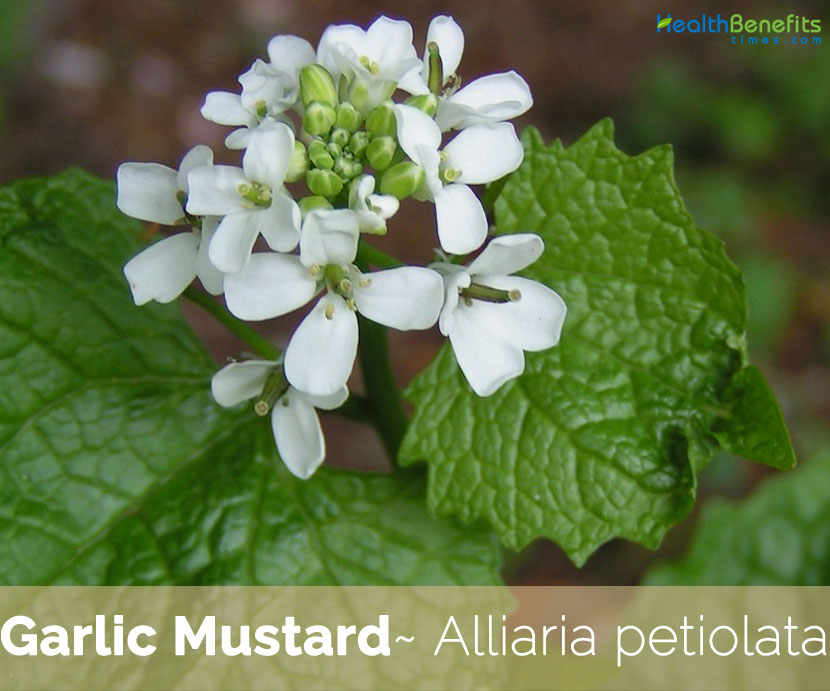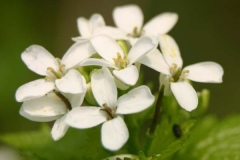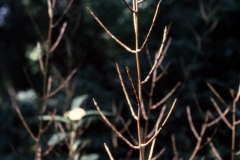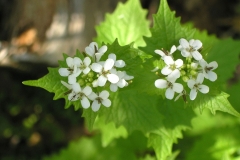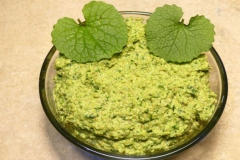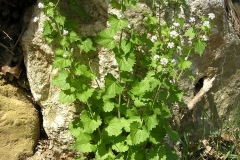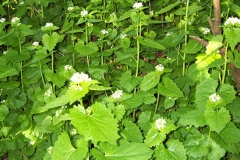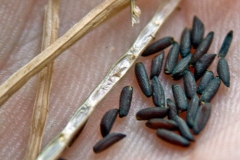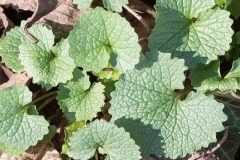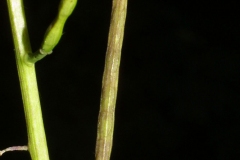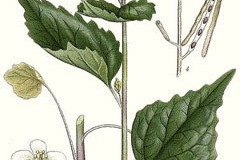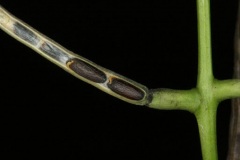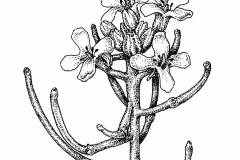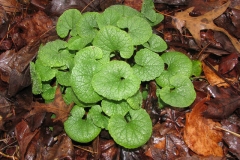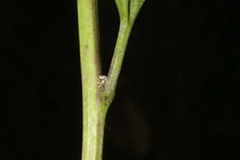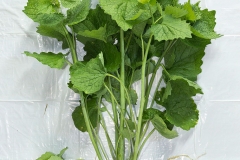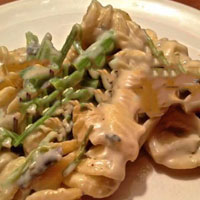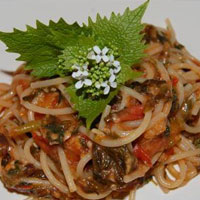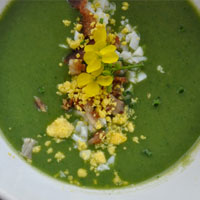| Garlic Mustard Quick Facts | |
|---|---|
| Name: | Garlic Mustard |
| Scientific Name: | Alliaria petiolata |
| Origin | Europe, western and central Asia, north-western Africa, Morocco, Iberia and the British Isles |
| Colors | Green maturing to pale grey brown |
| Shapes | Erect, slender, four-sided capsule 4–5.5 cm (1.6–2.2 in) long |
| Taste | Very spicy somewhat like horseradish (Root) |
| Health benefits | Beneficial for bronchitis, asthma, eczema, gangrene, ulcers, dropsy, induce hunger, treat wounds, relieve itching |
| Name | Garlic Mustard |
|---|---|
| Scientific Name | Alliaria petiolata |
| Native | Europe, western and central Asia, north-western Africa, Morocco, Iberia and the British Isles, north to northern Scandinavia, and east to northern Pakistan and Xinjiang in western China |
| Common Names | Garlic-root, garlicwort, hedge-garlic, Jack-by-the-hedge, Jack-in-the-bush, mustard-root, poor-man’s-mustard, sauce-alone, garlic mustard plant |
| Name in Other Languages | Albanian: Bar hadhre, bar hudhre, barëhudhëre mjekësore Arabic: thawmiat mueanaqa (ثومية معنقة), samarat thawmia (سمارة ثومية) Armenian: Skhtorabuys deghatu (Սխտորաբույս դեղատու) Basque: Baratxuri-belar, apo-baratxuri, baracaiz bedarra, sorgin-baratxuri Belarusian: Časnočnica čarankovaja (Часночніца чаранковая) Bokmal: Laukurt, Løkurt Bulgarian: Lŭzhichina (лъжичина), lechebna lŭzhichina (лечебна лъжичина), chesnova treva (чеснова трева) Catalan: Allenc, alliària Chinese: Cōng gài shǔ (葱芥属) Croatian: Češnjevka, ljekovita češnjača Czech: Cesnáček lékařský Danish: Løgkarse, Almindelig Løgkarse Dutch: Look-zonder-look English: Garlic-root, garlicwort, hedge-garlic, Jack-by-the-hedge, Jack-in-the-bush, mustard-root, poor-man’s-mustard, sauce-alone, garlic mustard plant Esperanto: Oficina aliario Estonian: Salukodrik Finnish: Litulaukka French: Alliaire, Alliaire officinale, Herbe à Ail, alliaire petiole, herbe aux aulx, julienne alliaire, vélar alliaire Gaelic: Gàirleach-callaid German: Gewöhnliche Knoblauchsrauke, Knoblauchsrauke, Knoblauchhederich, Knoblauchskraut, Knoblauchrauke, Lauchhederich, Lauchkraut, gemeine Knoblauchsrauke, gemeines Lauchkraut, Knoblauchkresse, Knoblauchskresse, Lauchel Greek: Alliára (αλλιάρα), alliaría farmakeftikí (αλλιαρία φαρμακευτική) Hebrew: Ali’aryah shumit, אָלִיאַרְיָה שׁוּמִית Hungarian: Kányazsombor Irish: Bóchoinneal Italian: Alliaria commune, Alliaria, Erba alliaria, rimandria Korean: Ma neul naeng I (마늘냉이) Latvian: Dziedniecibas kiplocene, ārstniecības ķiplocene Limburgan: Look zonder look, Look zoonder look, Louk zónger louk, Lithuanian: Vaistinė česnakūnė, Česnakūnė Luxembourgish: Bloderkraut Netherlands: Netherlands: Look-zonder-look Norwegian: Laukurt Persian: گندنایی Polish: Czosnaczek Pospolity, Czosnaczek Portuguese: Lunaria biënnis, erva alheira, aliária, erva-dos-alhos Romanian: Aişoară, ustroiță pețiolată, usturoiță, vindecătoare Russian: Chesnochnik lekarstvennyy (Чесночник лекарственный), Chesnochnitsa chereshkovaya (Чесночница черешковая), chesnochnik chereshkovyĭ (чесночник черешковый) Serbian: Lukovac (луковац), obična češnjača (обична чешњача) Slovak: Cesnačka lekárska, rancesnak lekársky Slovene: Cesnovka Spanish: Ajera, Aliaria, hierba ajera, hierba de ajo, hierba del ajo, hoja del gañán, yerba de ajo, yerba del ajo, yerba que huele a ajos, zancaraña, Ajo mostaza, ajo mostava Swedish: Löktrav, Vitlöksört Turkish: Sarmısak out, sarımsak hardalı Ukrainian: Kinsʹkyy chasnyk chereshkovyy (Кінський часник черешковий), kinsʹkyy chasnyk likarsʹkyy (кінський часник лікарський) Walloon: A des håyes Welsh: Garlleg y berth |
| Plant Growth Habit | Established, cool-season, monocarpic, tap rooted, herbaceous biennial or occasional winter annual |
| Growing Climates | Grows singly in hedges, fencerows, open woods, disturbed areas, deciduous forest, oak savanna, forest edges, shaded roadsides, urban areas, riparian zones, ruderal/ disturbed, floodplain forests, along trails, fence lines, swamps, ditches, roadsides, railway embankments |
| Soil | Grows on sand, loam, and clay soils, and on both limestone and sandstone substrates, and is rarely found on peat or muck soils |
| Plant Size | 30–100 cm (12–39 in) tall, rarely to 130 cm (51 in) tall |
| Root | Slender, white, taproot, with a distinctive “s” curve at the top of the root, just below the root crown |
| Stem | Erect and sparsely hairy and unbranched below the inflorescences. They can grow over 90 cm tall but are generally between 30 and 46 cm tall. |
| Leaf | Stalked, triangular through heart shaped, 10–15 cm (3.9–5.9 in) long (of which about half being the petiole) and 5–9 cm (2.0–3.5 in) broad, with coarsely toothed margins |
| Flowering season | April to June |
| Flower | Flowers are produced in spring and summer in small clusters. Each small flower has four white petals 4–8 mm (0.2–0.3 in) long and 2–3 mm (0.08–0.12 in) broad, arranged in a cross shape. |
| Fruit Shape & Size | Erect, slender, four-sided capsule 4–5.5 cm (1.6–2.2 in) long, called a silique containing two rows of small shiny black seeds which are released when a silique splits open. |
| Fruit Color | Green maturing to pale grey brown |
| Plant Parts Used | Flowers, leaves, stem, roots and seeds |
| Seed | Black, cylindrical about 3 mm long and 1 mm wide and transversely ridged, and range in weight from 1.62-2.84 mg |
| Taste | Very spicy somewhat like horseradish (Root) |
| Season | June to August |
| Precautions |
|
Plant description
Garlic Mustard is an established, cool-season, monocarpic, tap rooted, herbaceous biennial or occasional winter annual plant that grows about 30–100 cm (12–39 in) tall, rarely to 130 cm (51 in) tall. The plant is grows singly in hedges, fence rows, open woods, disturbed areas, deciduous forest, oak savanna, forest edges, shaded roadsides, urban areas, riparian zones, ruderal/disturbed, floodplain forests, along trails, fence lines, swamps, ditches, roadsides and railway embankments. It grows on sand, loam, and clay soils, and on both limestone and sandstone substrates, and is rarely found on peat or muck soils. The plant has a slender, white, taproot with a distinctive “s” curve at the top of the root, just below the root crown. Stems are erect and sparsely hairy and unbranched below the inflorescences. They can grow over 90 cm tall but are generally between 30 and 46 cm tall.
Leaves
The leaves of 1st year plants are up to 2 inches long and across. They are cordate-orbicular with margins that are dentate or wavy and their upper surface has a reticulated network of veins. The petioles of these basal leaves are rather long and slender. The alternate leaves of 2nd year plants have a similar appearance, except that they are usually longer than wide, spanning up to 3 inches long and 2 inches across. The lower and middle leaves along the stems are usually cordate with either acute or blunt tips, while the upper leaves are often ovate. Both the stems and petioles of 2nd year plants are occasionally hairy, otherwise they are glabrous like the blades of the leaves. The foliage is often light green or yellowish green in appearance, otherwise it is medium green. New leaves produce a distinct garlic odor when crushed. The fragrance fades as leaves age, and is virtually non-existent by fall.
Flower
Plants usually produce a single unbranched or few-branched flower stalk, although robust plants have been recorded with up to 12 separate flowering stalks. Flowers are produced in spring (usually April to May) in terminal racemes, and occasionally in short axillary racemes. Garlic mustard flowers are easy to recognize. The outside of the mustard flower has four sepals, usually green. The flower itself has four petals usually arranged in the shape of a cross. It has six stamens: four are tall and two are short. Flowers usually appear in a cluster. Each flower measures 1 to 1.5 cm across. Flowers can appear at any time throughout the growing season of year two of the plant’s growth.
Fruit and seeds
Fertile flowers are replaced by narrow seedpods that are called “siliques.” These seedpods are linear, 2.5 to 6.0 cm long and about 2 mm wide and are narrowly cylindrical. A single plant can produce two to over four hundred fruits (with an average of twenty-two per plant). The fruits ripen between mid-June and September. Fruits are initially green maturing to pale grey brown. Each fruit contains approximately sixteen seeds. Seeds are black, cylindrical about 3 mm long and 1 mm wide and transversely ridged, and range in weight from 1.62-2.84 mg. A single plant is capable of producing up to 8000 seeds in a single season! Seeds are contained in tan seedpods that are capable of ejecting the ripened seeds several feet away from the stem of the plant. Seeds must lay dormant for at least one year before germinating in the spring. Cold stratification is required to trigger seed germination. The seeds can remain viable in the soil for up to five years (a factor that further complicates the removal of an established garlic mustard population). Seeds can be transported great distances on boots of hikers or even on the tires of vehicles.
Traditional uses and benefits of Garlic Mustard
- Garlic mustard has been little used in herbal medicine.
- Leaves and stems are anti-asthmatic, antiscorbutic, antiseptic, deobstruent, diaphoretic, vermifuge and vulnerary.
- Leaves have been taken internally to promote sweating and to treat bronchitis, asthma and eczema.
- Externally, they have been used as an antiseptic poultice on ulcers etc., and are effective in relieving the itching caused by bites and stings.
- Roots are chopped up small and then heated in oil to make an ointment to rub on the chest in order to bring relief from bronchitis.
- Juice of the plant has an inhibitory effect on Bacillus pyocyaneum and on gram-negative bacteria of the typhoid-paratyphoid-enteritis group.
- Seeds have been used as a snuff to excite sneezing.
- Leaves can be used as a sudorific and deobstruent when taken internally, or as an external treatment for gangrene and ulcers.
- Leaf juices taken alone or boiled in syrup with honey were used to treat dropsy.
- Garlic mustard was once used medicinally as a disinfectant or diuretic, and was sometimes used to treat wounds.
- Leaves have been consumed to bring relief to congested chest and eczema.
- For relieving skin irritations and insect bites, these leaves might be beneficial.
- It can be used for stimulating appetite and inducing hunger which is often affected due to internal illness.
- It can be effective for keeping respiratory problems in check.
- Mild garlic and mustard flavor, the leaves are also believed to strengthen the digestive system.
Culinary Uses
- Young leaves can be consumed raw or cooked as a potherb or as a flavoring in cooked foods.
- They can be finely chopped and added to salads.
- Leaves are available very early in the year and provide a very acceptable flavoring for salads in the winter.
- Flowers and young seed pods can be consumed raw.
- Garlic mustard’s flower, leaf and young fruit are used raw or cooked both as a vegetable and for flavoring.
- Leaves and flowers have mild aromatic taste and flavor and are used as a spice and flavoring in cooked foods.
- Leaves are used as a winter salad vegetable and as a flavoring in cooked food.
- Leaves of the plant just prior to flowering have higher vitamin C content than oranges and more vitamin A than spinach and the species has considerable nutritional value when used in salads.
- Leaves give a mild garlic- mustard flavor to a dish.
- Leaves are commonly used to flavor stews and soups and also used as a stuffing in snacks.
- Leaves are stir-fried along with other vegetables for a healthy garlic-mustard-flavored side dish.
- Rural people often used the plant in the preparation of sauces.
Other Facts
- Yellow dye is obtained from the whole plant.
- Single plant can produce hundreds of seeds, which often scatter several meters from the parent plant.
- The herb was also planted as a form of erosion control.
- They can repel insects by emitting garlic like smell.
Prevention and Control
Due to the variable regulations around (de)registration of pesticides, your national list of registered pesticides or relevant authority should be consulted to determine which products are legally allowed for use in your country when considering chemical control. Pesticides should always be used in a lawful manner, consistent with the product’s label.
1. Cultural Control
The goal of any A. petiolata management program must be to prevent seed production. Because of the presence of a seed bank, whatever control method is employed, it must be continued for a period of no less than 3 years in order to eradicate the species locally. A. petiolata is not effectively controlled by grazing, and is under little to no vertebrate herbivore pressure in North America. Cavers et al. noted no grazing from white – tailed deer and only occasional consumption by cows in Ontario, Canada, resulting in an unpleasant taste to the milk.
2. Mechanical Control
Hand pulling is an effective approach for control, particularly with small or newly formed populations. When the plants have fastened in the second growing season, the stem may be easily grasped and pulled; roots will usually come out intact along with the stem. Because the fruit is photosynthetic, if fruit development has started, plants should not be left on site or hung from neighboring vegetation as the fruits are well known to continue to develop and dehisce even while lying on the ground, thus plants should be bagged and taken off site. Given the presence of a seed bank, repeated visits to a habitat over a number of years will be required to eradicate the plant. Likewise, cutting may provide good control, but cutting at ground level is important as plants that have been mown often respond by sending up new flowering shoots from the root crown. Nuzzo found that plants cut at ground level had 99% mortality and no seed production, whereas plants cut at a height of 10 cm had 71% mortality and seed production reduced by 98%. The use of cutting must be weighed against various factors, for example, certain other species that may be growing in association with A. petiolata such as native Trillium spp. are severely damaged by cutting.
3. Chemical Control
Foliar application of herbicides can be used to control A. petiolata where mechanical methods are impractical due to population size. Glyphosate, triclopyr, and mecoprop have all been used effectively to control A. petiolata, and because these herbicides are not target specific, they should be applied to A. petiolata during the dormant season where the plant is in the rosette stage and native vegetation has not yet emerged. However, biologically active temperatures are also usually required for certain herbicides to be effective. Thus, the window of time for application may be narrow. Acifluoren, bentazon and 2, 4-D is not recommended for control of A. petiolata.
4. Biological Control
There is currently no known biological control program in use to control A. petiolata. However, Blossey et al. indicate that they are investigating a variety of species for possible use as biological control agents. Although A. petiolata is under virtually no herbivore pressure in North American habitats, over 70 species of insect herbivores and seven fungi are associated with this plant in Europe. Many are not sufficiently host specific to use for control; five monophagous weevils and one oligophagous flea beetle are being further investigated in an effort to develop a concerted suite of attack agents for the seeds, stems, and roots.
5. Integrated Control
Nuzzo suggests that a suite of cutting, chemical, and fire control methods can be adopted for eradication as long as they are applied sequentially for 3 years or more to exhaust the seed bank. The use of fire as a control method for A. petiolata has been well studied, but the results are somewhat conflicting. Nuzzo found that fire reduced populations of A. petiolata and that the effect was related to fire intensity; moderate intensity fires were effective whereas low intensity fires had virtually no effect. As many prescribed fires fall into this latter category, the efficacy of fire alone to control A. petiolata is questionable, but it may be used effectively in combination with other methods. Nuzzo et al. found that A. petiolata was maintained, but in a reduced condition, in forests burned repeatedly for 5 years. However, Luken and Shea found that moderate intensity dormant season fires did nothing to reduce A. petiolata abundance, and in many plots the species actually increased in abundance relative to control plots. The use of fire as a management tool should be integrated with other management objectives given the manifold effects it has on a habitat.
Recipes
Garlic Mustard & Blue Cheese Pasta
Ingredients
- 200 g garlic mustard stems
- 30 g butter
- 25 g plain flour
- 400 ml milk
- 100 g Saint Agur blue cheese (or equivalent)
- pasta
- cracked black pepper
Directions
- Chop the garlic mustard stems then bring a pan of water to the boil, place the stems into it and bring back to the boil, then drain and set aside.
- Now bring a pan of water to the boil and cook enough pasta for two people. While it is cooking…
- Put the butter into a small saucepan and on low heat wait until it has melted, then add the flour and cook stirring all the time for about a minute.
- Make sure the flour does not burn. Then remove from the heat and slowly add the milk a little at a time making sure to stir continuously.
- Return to the heat and keep adding splashes of milk until it has all been added and is going thick.
- Then simmer the sauce for a further minute, and when done add the crumbled/chopped blue cheese, and stir until melted into the sauce.
- Mix together the garlic mustard stems pasta and sauce and serve.
Garlic Mustard & Cow Parsley Sauce
Ingredients
- 50 g garlic mustard tips (shredded & chopped )
- 400 g vine-ripened cherry tomatoes (chopped)
- 1 red chili (chopped)
- 50 g cow parsley shoots & buds
- 1 banana (chopped)
- 1 tbs. honey
- 2 tbs. tomato purée
- 30 g Parmesan cheese
- 3 tbs. oil/butter
Directions
- Heat oil and add the chili and garlic mustard tips, and cook on medium for 3 minutes.
- Add the cherry tomatoes, banana, tomato purée & honey. Mix ingredients and simmer on low for 30 minutes.
- Add chopped cow parsley, parmesan cheese, then put a lid on the saucepan, remove it from the heat and leave for 20 minutes.
- Cook some spaghetti, and when done serve with the garlic mustard sauce.
Garlic Mustard Vichyssoise
Ingredients
- 75 g butter
- 1 onion, chopped
- 75 g three cornered garlic stems
- 800 ml water
- 1 large potato, peeled, diced and rinsed
- Salt and freshly ground black pepper
- 75 g Jack by the hedge/garlic mustard
- 75 g goat’s cheese
- 75 ml milk for foam
- Pinch cumin
- Pinch white pepper
Directions
- In a heavy bottomed pan add water and potatoes and a good pinch of salt and boil until potatoes are soft. Remove from the heat and set aside.
- Melt the butter in a medium saucepan. Add the onion and cook until softened. Pour over the boiled potatoes and water.
- Blitz in food processor until smooth. Add water if required to the correct consistency. Pass through a sieve.
- Chill in the fridge. Check seasoning.
- Blanch jack by the hedge for 10 seconds in salted boiling water and refresh in ice water.
- Add jack by the hedge and blitz again until smooth.
- Then add the three cornered garlic blitz until smooth, check for seasoning again.
- Serve with some crumbled goats cheese, frothed milk, a pinch of cumin, some crispy fried nettle dusted with white pepper and a three corned garlic flower
References:
https://www.itis.gov/servlet/SingleRpt/SingleRpt?search_topic=TSN&search_value=184481#null
https://pfaf.org/user/plant.aspx?LatinName=Alliaria+petiolata
https://www.cabi.org/isc/datasheet/3941
https://plants.usda.gov/core/profile?symbol=ALPE4
https://en.wikipedia.org/wiki/Alliaria_petiolata
https://npgsweb.ars-grin.gov/gringlobal/taxonomydetail.aspx?id=2210
https://www.fs.fed.us/database/feis/plants/forb/allpet/all.html
https://www.invasive.org/browse/subinfo.cfm?sub=3005
https://www.conservemc.org/images/documents/USDA-Garlic-Mustard-Article.pdf
http://tn-grin.nat.tn/gringlobal/taxonomydetail.aspx?id=2210
http://www.iucngisd.org/gisd/species.php?sc=406
http://www.theplantlist.org/tpl1.1/record/kew-2628680
https://www.flowersofindia.net/catalog/slides/Garlic%20Mustard.html
https://gd.eppo.int/taxon/ALAPE


